- 09-Pagination
- 发布用户动态
- 加入动态分页
- 首页中的分页
- 个人主页中的分页
- 更容易地发现和关注用户
- Links
09-Pagination
在本章,我将告诉你如何对数据列表进行分页。
在第八章我们支持了社交网络非常流行的“粉丝”机制。 有了这个功能,接下来我准备好删除一开始就使用的模拟用户动态了。 在本章中,应用将开始接受来自用户的动态更新,并将其发布到网站首页和个人主页。
本章的GitHub链接为: Source, Diff,
Zip
发布用户动态
简言之,就是发布Post,首页需要有一个表单,用户可以在其中键入新动态。
不过在这之前,我们先支持下 flash message
controller/g.go
...var (homeController hometemplates map[string]*template.TemplatesessionName stringflashName stringstore *sessions.CookieStore)func init() {templates = PopulateTemplates()store = sessions.NewCookieStore([]byte("something-very-secret"))sessionName = "go-mega"flashName = "go-flash"}...
controller/utils.go
...func setFlash(w http.ResponseWriter, r *http.Request, message string) {session, _ := store.Get(r, sessionName)session.AddFlash(message, flashName)session.Save(r, w)}func getFlash(w http.ResponseWriter, r *http.Request) string {session, _ := store.Get(r, sessionName)fm := session.Flashes(flashName)if fm == nil {return ""}session.Save(r, w)return fmt.Sprintf("%v", fm[0])}
然后我们就可以使用 flash message 来提示 error message了
现在我们来完成发布Post功能
vm/index.go
package vmimport "github.com/bonfy/go-mega-code/model"// IndexViewModel structtype IndexViewModel struct {BaseViewModelPosts []model.PostFlash string}// IndexViewModelOp structtype IndexViewModelOp struct{}// GetVM funcfunc (IndexViewModelOp) GetVM(username string, flash string) IndexViewModel {u, _ := model.GetUserByUsername(username)posts, _ := u.FollowingPosts()v := IndexViewModel{BaseViewModel{Title: "Homepage"}, *posts, flash}v.SetCurrentUser(username)return v}// CreatePost funcfunc CreatePost(username, post string) error {u, _ := model.GetUserByUsername(username)return u.CreatePost(post)}
Notice: 这里我们顺便将 IndexView 里的 Posts 改成 CurrentUser 的 FollowingPosts
templates/content/index.html
{{define "content"}}<h1>Hello, {{.CurrentUser}}!</h1><form action="/" method="post"><p><textarea name="body" rows="3" cols="80" value="" placeholder="say something..."></textarea></p><p><input type="submit" name="submit" value="Post"></p>{{ if .Flash }}<span style="color: red;">[{{.Flash}}]</span>{{ end }}</form>{{range .Posts}}<table><tr valign="top"><td><img src="{{.User.Avatar}}&s=36"></td><td>{{ .User.Username }} says:<br>{{ .Body }}</td></tr></table>{{end}}{{end}}
controller/home.go
...func indexHandler(w http.ResponseWriter, r *http.Request) {tpName := "index.html"vop := vm.IndexViewModelOp{}username, _ := getSessionUser(r)if r.Method == http.MethodGet {flash := getFlash(w, r)v := vop.GetVM(username, flash)templates[tpName].Execute(w, &v)}if r.Method == http.MethodPost {r.ParseForm()body := r.Form.Get("body")errMessage := checkLen("Post", body, 1, 180)if errMessage != "" {setFlash(w, r, errMessage)} else {err := vm.CreatePost(username, body)if err != nil {log.Println("add Post error:", err)w.Write([]byte("Error insert Post in database"))return}}http.Redirect(w, r, "/", http.StatusSeeOther)}}...
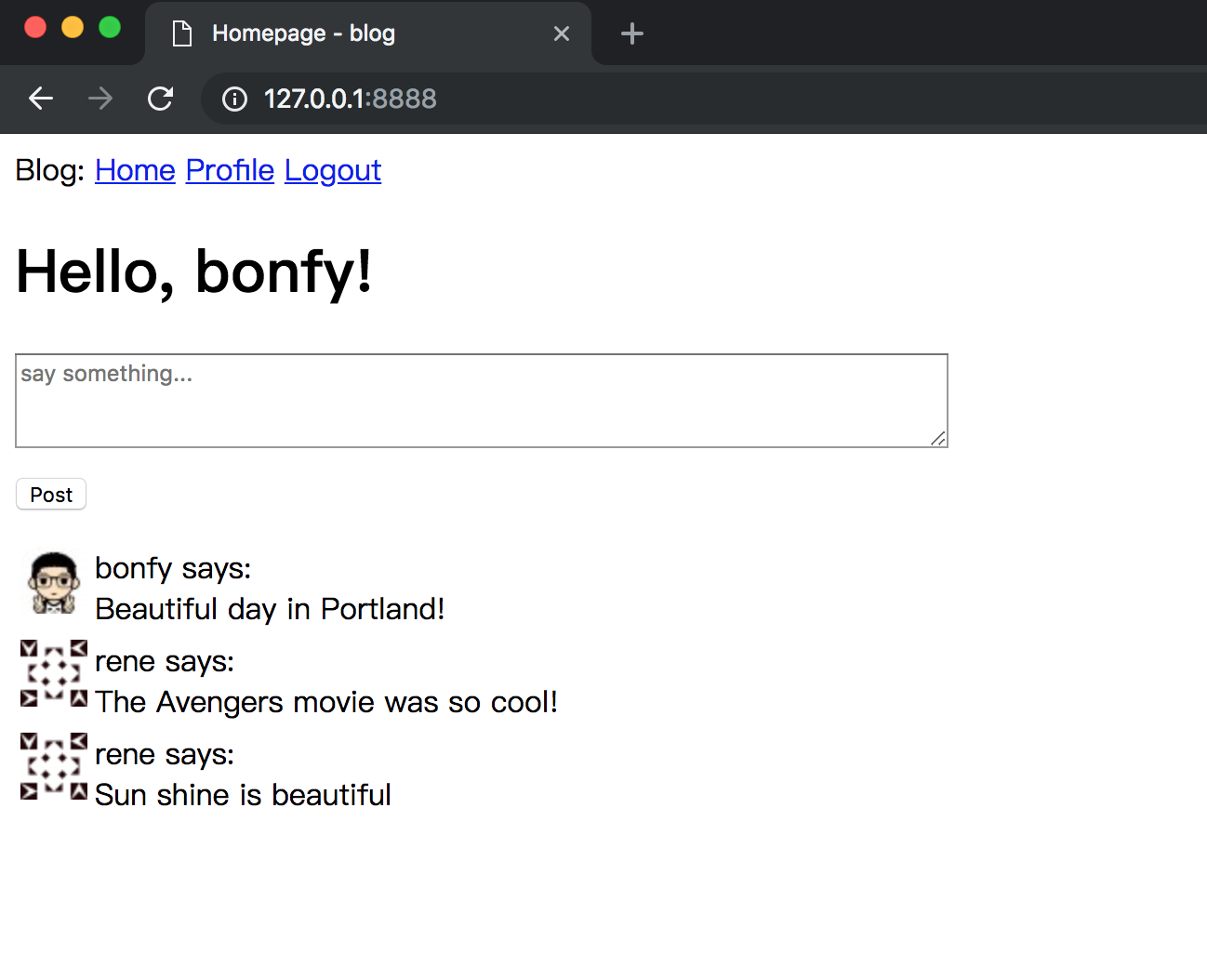
Notice: 这里由于我们上章初始化数据 bonfy follow了 rene,所以这里 bonfy 看到的 Index 页面中也有rene的Post,如果登陆rene的账户,是看不到bonfy的Post的,因为 rene 没有follow bonfy
我们现在在输入框中什么都不输入,直接点Post,就能看到 Flash 的 红色提示了
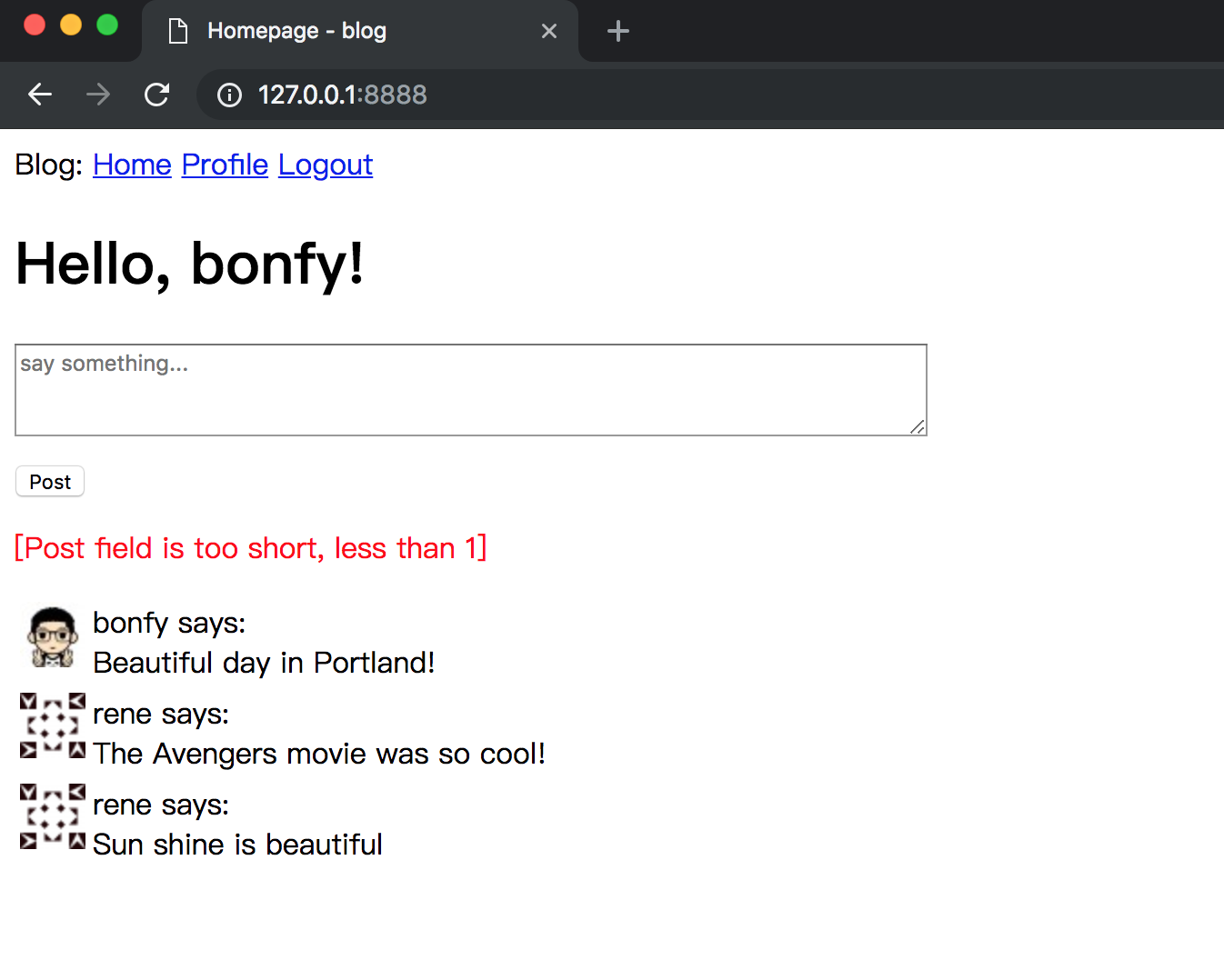
本小节 Diff
加入动态分页
应用看起来更完善了,但是在主页显示所有用户动态迟早会出问题。如果一个用户有成千上万条关注的用户动态时,会发生什么?你可以想象得到,管理这么大的用户动态列表将会变得相当缓慢和低效。
为了解决这个问题,我会将用户动态进行分页。这意味着一开始显示的只是所有用户动态的一部分,并提供链接来访问其余的用户动态。
我们先在 controller/g.go 中增加页数设置 pageLimit (其实更灵活点,也可以将它放入到配置文件中)
controller/g.go
...var (homeController hometemplates map[string]*template.TemplatesessionName stringflashName stringstore *sessions.CookieStorepageLimit int)func init() {templates = PopulateTemplates()store = sessions.NewCookieStore([]byte("something-very-secret"))sessionName = "go-mega"flashName = "go-flash"pageLimit = 5}...
接下来,我需要决定如何将页码并入到应用URL中。 一个相当常见的方法是使用查询字符串参数来指定一个可选的页码,如果没有给出则默认为页面1。 以下是一些示例网址,显示了我将如何实现这一点:
- 第1页,隐含:http://localhost:8888/
- 第1页,显式:http://localhost:8888/?page=1
- 第3页:http://localhost:8888/?page=3
要访问查询字符串中给出的参数,我们在 utils 中创建一个函数,方便以后调用
...func getPage(r *http.Request) int {url := r.URL // net/url.URLquery := url.Query() // Values (map[string][]string)q := query.Get("page")if q == "" {return 1}page, err := strconv.Atoi(q)if err != nil {return 1}return page}
在 vm 中建立分页的 BasePageViewModel
- PrevPage: 上一页的页码
- NextPage: 下一页的页码
- Total: 总页数
- CurrentPage: 当前页码
- Limit: 每页显示项目数
vm/g.go
...// BasePageViewModel structtype BasePageViewModel struct {PrevPage intNextPage intTotal intCurrentPage intLimit int}// SetPrevAndNextPage funcfunc (v *BasePageViewModel) SetPrevAndNextPage() {if v.CurrentPage > 1 {v.PrevPage = v.CurrentPage - 1}if (v.Total-1)/v.Limit >= v.CurrentPage {v.NextPage = v.CurrentPage + 1}}// SetBasePageViewModel funcfunc (v *BasePageViewModel) SetBasePageViewModel(total, page, limit int) {v.Total = totalv.CurrentPage = pagev.Limit = limitv.SetPrevAndNextPage()}
首页中的分页
model 中增加 FollowingPosts 的分页处理
model/user.go
...// FollowingPostsByPageAndLimit funcfunc (u *User) FollowingPostsByPageAndLimit(page, limit int) (*[]Post, int, error) {var total intvar posts []Postoffset := (page - 1) * limitids := u.FollowingIDs()if err := db.Preload("User").Order("timestamp desc").Where("user_id in (?)", ids).Offset(offset).Limit(limit).Find(&posts).Error; err != nil {return nil, total, err}db.Model(&Post{}).Where("user_id in (?)", ids).Count(&total)return &posts, total, nil}...
index 的 vm 中加入 BasePageViewModel
vm/index.go
...type IndexViewModel struct {BaseViewModelPosts []model.PostFlash stringBasePageViewModel}// IndexViewModelOp structtype IndexViewModelOp struct{}// GetVM funcfunc (IndexViewModelOp) GetVM(username, flash string, page, limit int) IndexViewModel {u, _ := model.GetUserByUsername(username)posts, total, _ := u.FollowingPostsByPageAndLimit(page, limit)v := IndexViewModel{}v.SetTitle("Homepage")v.Posts = *postsv.Flash = flashv.SetBasePageViewModel(total, page, limit)v.SetCurrentUser(username)return v}...
显示页中加入页码
templates/content/index.html
...{{range .Posts}}<table><tr valign="top"><td><img src="{{.User.Avatar}}&s=36"></td><td><a href="/user/{{.User.Username}}">{{ .User.Username }}</a> says:<br>{{ .Body }}</td></tr></table>{{end}}{{ if gt .PrevPage 0 }}<a href="/?page={{.PrevPage}}">Newer posts</a>{{ end }}{{ if gt .NextPage 0 }}<a href="/?page={{.NextPage}}">Older posts</a>{{ end }}...
Notice: 这里我们顺便在 Posts显示的时候将 Username 上加了 “/user/username” 的链接,方便我们快速访问用户profile
controller修改成新的 GetVM
...func indexHandler(w http.ResponseWriter, r *http.Request) {tpName := "index.html"vop := vm.IndexViewModelOp{}page := getPage(r)username, _ := getSessionUser(r)if r.Method == http.MethodGet {flash := getFlash(w, r)v := vop.GetVM(username, flash, page, pageLimit)templates[tpName].Execute(w, &v)}if r.Method == http.MethodPost {r.ParseForm()body := r.Form.Get("body")errMessage := checkLen("Post", body, 1, 180)if errMessage != "" {setFlash(w, r, errMessage)} else {err := vm.CreatePost(username, body)if err != nil {log.Println("add Post error:", err)w.Write([]byte("Error insert Post in database"))return}}http.Redirect(w, r, "/", http.StatusSeeOther)}}...
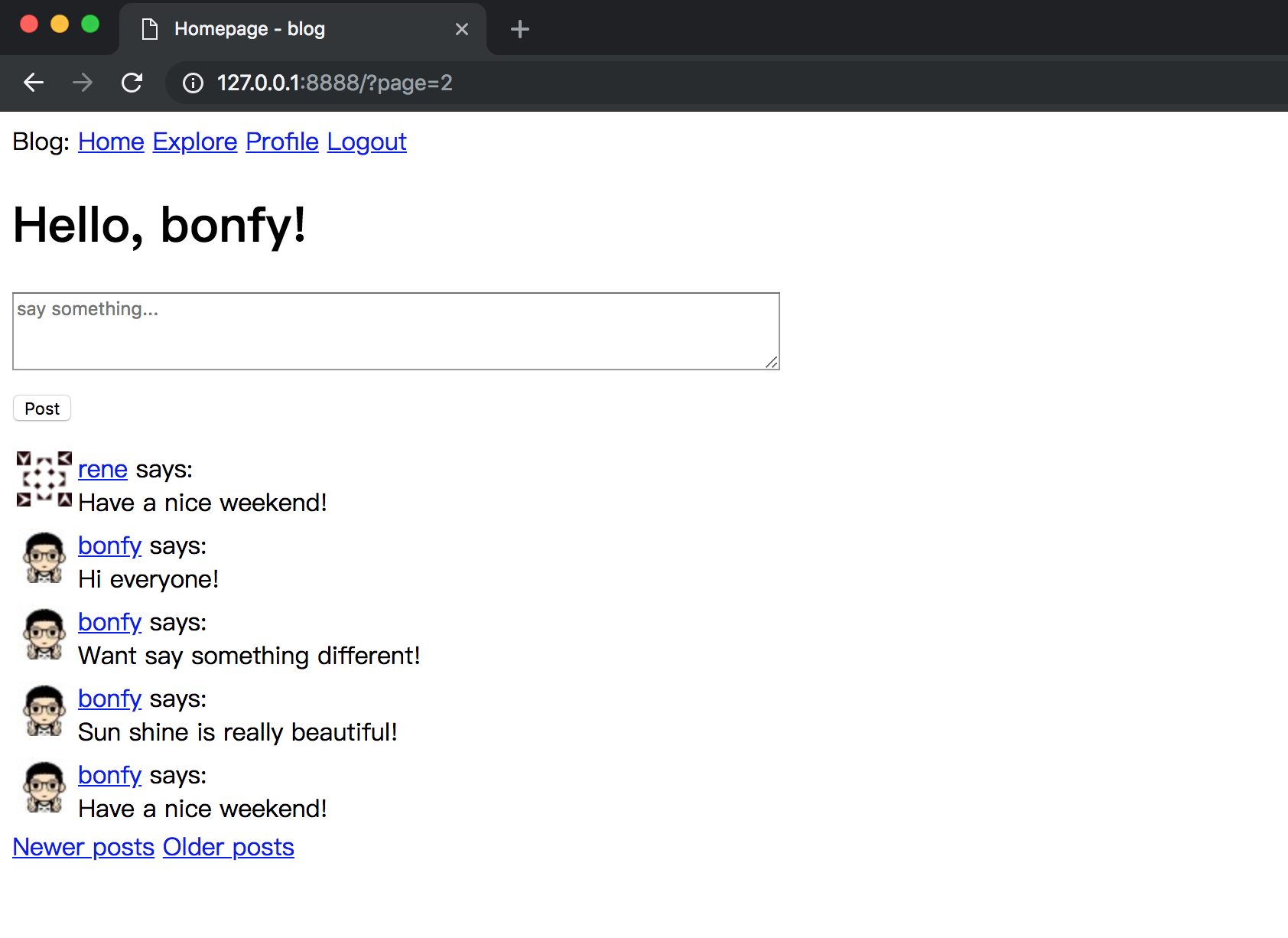
个人主页中的分页
与首页分页类似,建立 profile 中的分页
model/post.go
...// GetPostsByUserIDPageAndLimit funcfunc GetPostsByUserIDPageAndLimit(id, page, limit int) (*[]Post, int, error) {var total intvar posts []Postoffset := (page - 1) * limitif err := db.Preload("User").Order("timestamp desc").Where("user_id=?", id).Offset(offset).Limit(limit).Find(&posts).Error; err != nil {return nil, total, err}db.Model(&Post{}).Where("user_id=?", id).Count(&total)return &posts, total, nil}
vm/profile.go
...// ProfileViewModel structtype ProfileViewModel struct {BaseViewModelPosts []model.PostEditable boolIsFollow boolFollowersCount intFollowingCount intProfileUser model.UserBasePageViewModel}// ProfileViewModelOp structtype ProfileViewModelOp struct{}// GetVM funcfunc (ProfileViewModelOp) GetVM(sUser, pUser string, page, limit int) (ProfileViewModel, error) {v := ProfileViewModel{}v.SetTitle("Profile")u, err := model.GetUserByUsername(pUser)if err != nil {return v, err}posts, total, _ := model.GetPostsByUserIDPageAndLimit(u.ID, page, limit)v.ProfileUser = *uv.Editable = (sUser == pUser)v.SetBasePageViewModel(total, page, limit)if !v.Editable {v.IsFollow = u.IsFollowedByUser(sUser)}v.FollowersCount = u.FollowersCount()v.FollowingCount = u.FollowingCount()v.Posts = *postsv.SetCurrentUser(sUser)return v, nil}...
templates/content/profile.html
...{{range .Posts}}<table><tr valign="top"><td><img src="{{.User.Avatar}}&s=36"></td><td><a href="/user/{{.User.Username}}">{{ .User.Username }}</a> says:<br>{{ .Body }}</td></tr></table>{{end}}{{ if gt .PrevPage 0 }}<a href="/user/{{.ProfileUser.Username}}?page={{.PrevPage}}">Newer posts</a>{{ end }}{{ if gt .NextPage 0 }}<a href="/user/{{.ProfileUser.Username}}?page={{.NextPage}}">Older posts</a>{{ end }}...
controller/home.go
...func profileHandler(w http.ResponseWriter, r *http.Request) {tpName := "profile.html"vars := mux.Vars(r)pUser := vars["username"]sUser, _ := getSessionUser(r)page := getPage(r)vop := vm.ProfileViewModelOp{}v, err := vop.GetVM(sUser, pUser, page, pageLimit)if err != nil {msg := fmt.Sprintf("user ( %s ) does not exist", pUser)w.Write([]byte(msg))return}templates[tpName].Execute(w, &v)}...
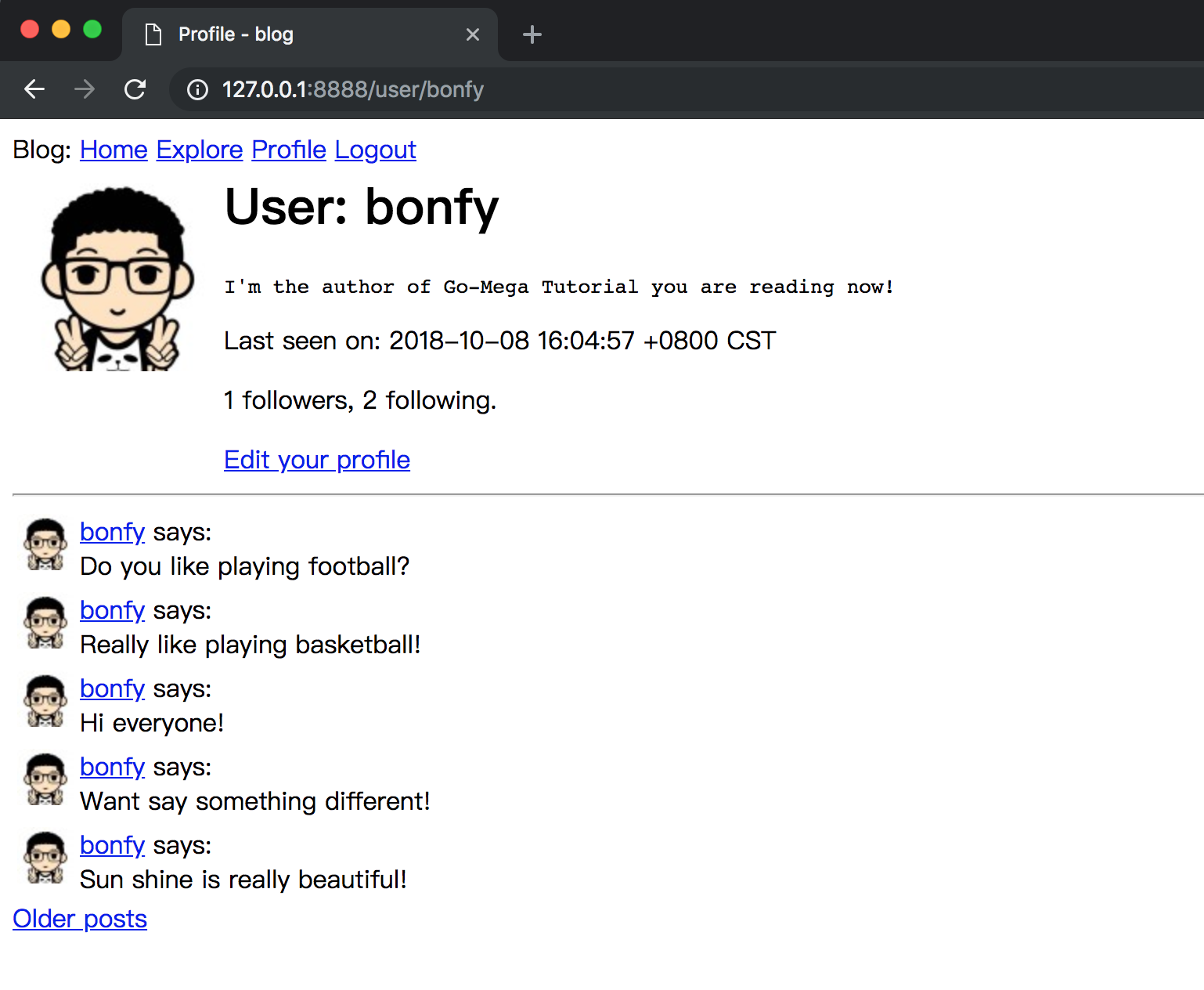
本小节 Diff
更容易地发现和关注用户
相信你已经留意到了,应用没有一个很好的途径来让用户可以找到其他用户进行关注。实际上,现在根本没有办法在页面上查看到底有哪些用户存在。我将会使用少量简单的变更来解决这个问题。
我将会创建一个新的Explore页面。该页面看起来像是主页,但是却不是只显示已关注用户的动态,而是展示所有用户的全部动态。
我们现在导航中加入Explore
templates/_base.html
...<a href="/">Home</a><a href="/explore">Explore</a>...
然后增加 Explore 页面, 不多说了,老套路
model/post.go
...// GetPostsByPageAndLimit funcfunc GetPostsByPageAndLimit(page, limit int) (*[]Post, int, error) {var total intvar posts []Postoffset := (page - 1) * limitif err := db.Preload("User").Offset(offset).Limit(limit).Order("timestamp desc").Find(&posts).Error; err != nil {return nil, total, err}db.Model(&Post{}).Count(&total)return &posts, total, nil}
vm/explore.go
package vmimport "github.com/bonfy/go-mega-code/model"// ExploreViewModel structtype ExploreViewModel struct {BaseViewModelPosts []model.PostBasePageViewModel}// ExploreViewModelOp structtype ExploreViewModelOp struct{}// GetVM funcfunc (ExploreViewModelOp) GetVM(username string, page, limit int) ExploreViewModel {// posts, _ := model.GetAllPosts()posts, total, _ := model.GetPostsByPageAndLimit(page, limit)v := ExploreViewModel{}v.SetTitle("Explore")v.Posts = *postsv.SetBasePageViewModel(total, page, limit)v.SetCurrentUser(username)return v}
templates/content/explore.html
{{define "content"}}<h1>Hello, {{.CurrentUser}}!</h1>{{range .Posts}}<table><tr valign="top"><td><img src="{{.User.Avatar}}&s=36"></td><td><a href="/user/{{.User.Username}}">{{ .User.Username }}</a> says:<br>{{ .Body }}</td></tr></table>{{end}}{{ if gt .PrevPage 0 }}<a href="/explore?page={{.PrevPage}}">Newer posts</a>{{ end }}{{ if gt .NextPage 0 }}<a href="/explore?page={{.NextPage}}">Older posts</a>{{ end }}{{end}}
controller/home.go
...func (h home) registerRoutes() {r := mux.NewRouter()r.HandleFunc("/logout", middleAuth(logoutHandler))r.HandleFunc("/login", loginHandler)r.HandleFunc("/register", registerHandler)r.HandleFunc("/user/{username}", middleAuth(profileHandler))r.HandleFunc("/follow/{username}", middleAuth(followHandler))r.HandleFunc("/unfollow/{username}", middleAuth(unFollowHandler))r.HandleFunc("/profile_edit", middleAuth(profileEditHandler))r.HandleFunc("/explore", middleAuth(exploreHandler))r.HandleFunc("/", middleAuth(indexHandler))http.Handle("/", r)}...func exploreHandler(w http.ResponseWriter, r *http.Request) {tpName := "explore.html"vop := vm.ExploreViewModelOp{}username, _ := getSessionUser(r)page := getPage(r)v := vop.GetVM(username, page, pageLimit)templates[tpName].Execute(w, &v)}
通过这些细小的变更,应用的用户体验得到了大大的提升。现在,用户可以访问发现页来查看陌生用户的动态,并通过这些用户动态来关注用户,而需要的操作仅仅是点击用户名跳转到其个人主页并点击关注链接。令人叹为观止!对吧?
此时,我建议你在应用上再次尝试一下这个功能,以便体验最后的用户接口的完善。
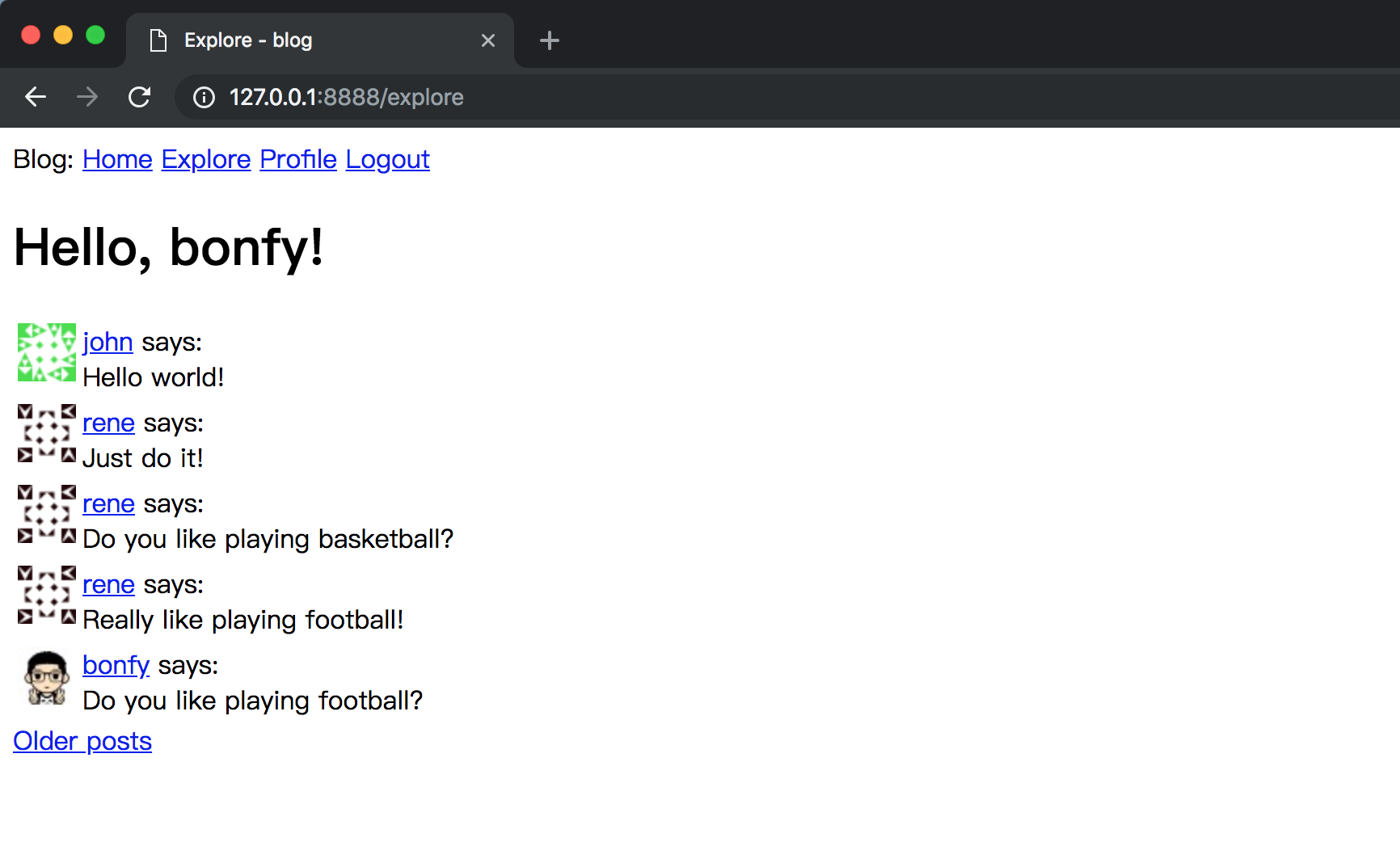
本小节 Diff
Links
- 目录
- 上一节: 08-Follower
- 下一节: 10-Email-Support
